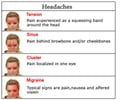New wireless super-arm patch has been designed to give non-painful electrical stimulation to reduce migraine pain.
- Previous methods of providing electrical stimulation for migraine relief involved use of wires that needed to be attached to the head.
- The new device has a patch that can be worn around the arm and can be controlled easily using a smartphone.
- The wireless device uses electrical stimulation to block the pain signals from reaching the brain.
Earlier methods of electrical stimulation for pain relief utilised devices that needed wires and were attached to the head.
Testing the Patch
The study involved 71 people who had episodic migraine with two to eight attacks per month. They had not taken any preventive medication for migraine for at least two months.As soon as an attack of migraine starts, participants were asked to place the device to their upper arm and use it for 20 minutes. They were not supposed to take any medications for migraine for two hours.
The participants were randomly assigned to a placebo group where they were given a sham stimulation at a very low frequency or to a group of active stimulation with one of four levels. The stimulation was designed to be non-painful.
Observations
At the three highest levels of active stimulation, 64% of people had a reduction in their pain by at least 50%, two hours after the treatment, compared to 26% of people during the sham stimulation.Around 30% in the same group said they had no pain after receiving the highest level of stimulation, compared to 6% who received the sham stimulation.
"These results are similar to those seen for the triptan medications for migraine," Yarnitsky said.
The researcher team also found that starting the stimulation within 20 minutes of the start of a migraine was more effective.
Around 47% of participants reported reduction in pain after early stimulation, compared to 25 percent who started stimulation after 20 minutes.
One limitation of the study was that during the sham stimulation, participants often stopped the treatment before completion of the 20-minute period.
"This may indicate that they knew the stimulation was not active, and thus they were no longer blinded to the study, which is a challenge in any sham stimulation study," Yarnitsky said.
"These results need to be confirmed with additional studies, but they are exciting," Yarnitsky added.
The study is published in the online issue of Neurology, the medical journal of the American Academy of Neurology.
Migraine
Migraine is a chronic condition characterized by headache, nausea, vomiting and sensitivity to light and sound. A typical migraine headache is often unilateral -occurs on one side of the head and is throbbing or pulsating in nature.Women are more prone to migraine headaches than men. Its prevalence is about 20% in females and 6% in males.
Migraine is more prevalent than diabetes, epilepsy and asthma combined, with an estimated global prevalence of 14.7%. It is considered to be the seventh most disabling disease among all diseases.
Chronic migraine affects approximately 2% of the world population.
Migraine attacks often start at puberty and affect mostly those aged between 35 and 45 years, though it can occur much earlier.
References:
- David Yarnitsky et al. Nonpainful remote electrical stimulation alleviates episodic migraine pain. Neurology; (2017) doi.org/10.1212/WNL.0000000000003760
- Facts and figures - (https://www.migrainetrust.org/about-migraine/migraine-what-is-it/facts-figures/)
Source-Medindia















